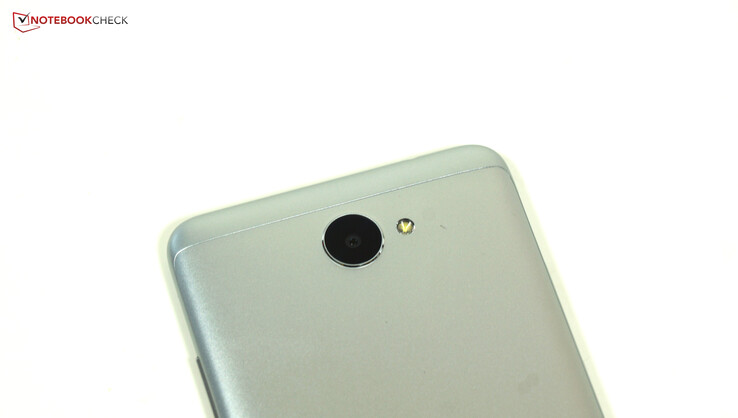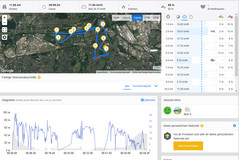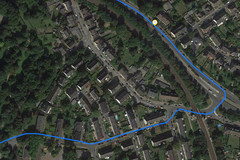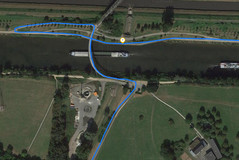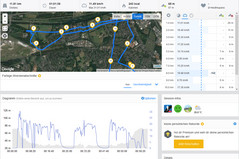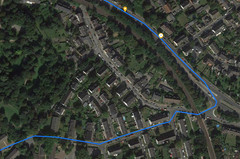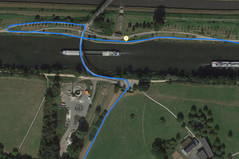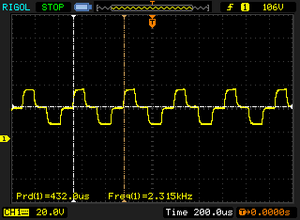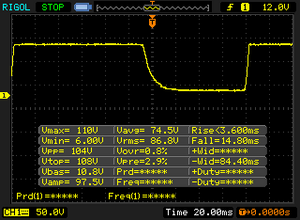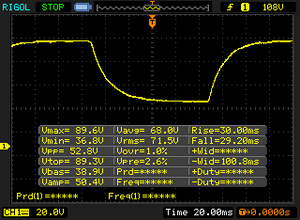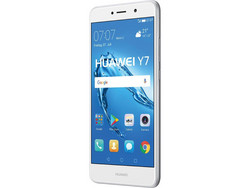Breve análisis del Smartphone Huawei Y7 (2017)
Top 10 Análisis
» Top 10 Portátiles Multimedia
» Top 10 Portátiles de Juego
» Top 10 Portátiles de Juego ligeros
» Top 10 Portátiles Asequibles de Oficina/Empresa
» Top 10 Portátiles de Juego Ligeros
» Top 10 Portátiles de Oficina/Empresa Premium
» Top 10 Estaciones de Trabajo
» Top 10 Subportátiles
» Top 10 Ultrabooks
» Top 10 Convertibles
» Top 10 Tablets
» Top 10 Tablets Windows
» Top 10 Tablets de menos de 250 Euros
» Top 10 Phablets (>5.5")
» Top 10 Smartphones
» Top 10 Smartphones (≤5")
» Top 10 Smartphones de menos de 300 Euros
» Top 10 Smartphones de menos de 120 Euros
» Top 10 Portátiles de menos de 1000 Euros
» Top 10 Portátiles de menos de 500 Euros
» Top 10 Portátiles de menos de 300 Euros
» Los Mejores Displays de Portátiles Analizados por Notebookcheck
| Networking | |
| iperf3 transmit AX12 | |
| Samsung Galaxy J7 2017 | |
| Sony Xperia L1 | |
| LG X power2 | |
| Huawei Y7 | |
| Huawei Y6 2017 | |
| Lenovo Moto E4 Plus | |
| iperf3 receive AX12 | |
| Samsung Galaxy J7 2017 | |
| Sony Xperia L1 | |
| Huawei Y7 | |
| LG X power2 | |
| Huawei Y6 2017 | |
| Lenovo Moto E4 Plus | |
| |||||||||||||||||||||||||
iluminación: 92 %
Brillo con batería: 467 cd/m²
Contraste: 1197:1 (Negro: 0.39 cd/m²)
ΔE ColorChecker Calman: 4.3 | ∀{0.5-29.43 Ø4.78}
ΔE Greyscale Calman: 3.5 | ∀{0.09-98 Ø5}
Gamma: 2.35
CCT: 7273 K
| Huawei Y7 IPS, 1280x720, 5.5" | Lenovo Moto E4 Plus IPS, 1280x720, 5.5" | LG X power2 IPS, 1280x720, 5.5" | Samsung Galaxy J7 2017 Super AMOLED, 1920x1080, 5.5" | Sony Xperia L1 IPS, 1280x720, 5.5" | Huawei Y6 2017 IPS, 1280x720, 5" | |
|---|---|---|---|---|---|---|
| Screen | -10% | -21% | 20% | -13% | 21% | |
| Brightness middle (cd/m²) | 467 | 425 -9% | 237 -49% | 454 -3% | 479 3% | 438 -6% |
| Brightness (cd/m²) | 456 | 425 -7% | 237 -48% | 463 2% | 478 5% | 432 -5% |
| Brightness Distribution (%) | 92 | 93 1% | 92 0% | 86 -7% | 94 2% | 90 -2% |
| Black Level * (cd/m²) | 0.39 | 0.37 5% | 0.13 67% | 0.58 -49% | 0.13 67% | |
| Contrast (:1) | 1197 | 1149 -4% | 1823 52% | 826 -31% | 3369 181% | |
| Colorchecker dE 2000 * | 4.3 | 4.7 -9% | 5.5 -28% | 2 53% | 4.5 -5% | 4.8 -12% |
| Colorchecker dE 2000 max. * | 6.8 | 8.3 -22% | 12.7 -87% | 5.3 22% | 7.5 -10% | 11.4 -68% |
| Greyscale dE 2000 * | 3.5 | 4.6 -31% | 6.1 -74% | 1.7 51% | 4.1 -17% | 3.2 9% |
| Gamma | 2.35 94% | 2.17 101% | 2.07 106% | 2.1 105% | 2.03 108% | 2.23 99% |
| CCT | 7273 89% | 7445 87% | 7943 82% | 6394 102% | 7139 91% | 7090 92% |
* ... más pequeño es mejor
Parpadeo de Pantalla / PWM (Pulse-Width Modulation)
| Parpadeo de Pantalla / PWM detectado | 2315 Hz | ≤ 14 % de brillo | |
La retroiluminación del display parpadea a 2315 Hz (seguramente usa PWM - Pulse-Width Modulation) a un brillo del 14 % e inferior. Sobre este nivel de brillo no debería darse parpadeo / PWM. La frecuencia de 2315 Hz es bastante alta, por lo que la mayoría de gente sensible al parpadeo no debería ver parpadeo o tener fatiga visual. Comparación: 53 % de todos los dispositivos testados no usaron PWM para atenuar el display. Si se usó, medimos una media de 8108 (mínimo: 5 - máxmo: 343500) Hz. | |||
Tiempos de respuesta del display
| ↔ Tiempo de respuesta de Negro a Blanco | ||
|---|---|---|
| 18.4 ms ... subida ↗ y bajada ↘ combinada | ↗ 3.6 ms subida | |
| ↘ 14.8 ms bajada | ||
| La pantalla mostró buenos tiempos de respuesta en nuestros tests pero podría ser demasiado lenta para los jugones competitivos. En comparación, todos los dispositivos de prueba van de ##min### (mínimo) a 240 (máximo) ms. » 40 % de todos los dispositivos son mejores. Eso quiere decir que el tiempo de respuesta es similar al dispositivo testado medio (20.2 ms). | ||
| ↔ Tiempo de respuesta 50% Gris a 80% Gris | ||
| 59.2 ms ... subida ↗ y bajada ↘ combinada | ↗ 30 ms subida | |
| ↘ 29.2 ms bajada | ||
| La pantalla mostró tiempos de respuesta lentos en nuestros tests y podría ser demasiado lenta para los jugones. En comparación, todos los dispositivos de prueba van de ##min### (mínimo) a 636 (máximo) ms. » 95 % de todos los dispositivos son mejores. Eso quiere decir que el tiempo de respuesta es peor que la media (31.6 ms) de todos los dispositivos testados. | ||
| AnTuTu v6 - Total Score (ordenar por valor) | |
| Huawei Y7 | |
| Lenovo Moto E4 Plus | |
| LG X power2 | |
| Samsung Galaxy J7 2017 | |
| Sony Xperia L1 | |
| Huawei Y6 2017 | |
| PCMark for Android | |
| Work performance score (ordenar por valor) | |
| Huawei Y7 | |
| Lenovo Moto E4 Plus | |
| LG X power2 | |
| Samsung Galaxy J7 2017 | |
| Sony Xperia L1 | |
| Huawei Y6 2017 | |
| Work 2.0 performance score (ordenar por valor) | |
| Huawei Y7 | |
| Lenovo Moto E4 Plus | |
| LG X power2 | |
| Samsung Galaxy J7 2017 | |
| Sony Xperia L1 | |
| Huawei Y6 2017 | |
| Geekbench 4.4 | |
| 64 Bit Single-Core Score (ordenar por valor) | |
| Huawei Y7 | |
| Lenovo Moto E4 Plus | |
| LG X power2 | |
| Samsung Galaxy J7 2017 | |
| Sony Xperia L1 | |
| Huawei Y6 2017 | |
| 64 Bit Multi-Core Score (ordenar por valor) | |
| Huawei Y7 | |
| Lenovo Moto E4 Plus | |
| LG X power2 | |
| Samsung Galaxy J7 2017 | |
| Sony Xperia L1 | |
| Huawei Y6 2017 | |
| Compute RenderScript Score (ordenar por valor) | |
| Huawei Y7 | |
| Lenovo Moto E4 Plus | |
| LG X power2 | |
| Samsung Galaxy J7 2017 | |
| Sony Xperia L1 | |
| Huawei Y6 2017 | |
| GFXBench (DX / GLBenchmark) 2.7 | |
| T-Rex Onscreen (ordenar por valor) | |
| Huawei Y7 | |
| Lenovo Moto E4 Plus | |
| LG X power2 | |
| Samsung Galaxy J7 2017 | |
| Sony Xperia L1 | |
| Huawei Y6 2017 | |
| 1920x1080 T-Rex Offscreen (ordenar por valor) | |
| Huawei Y7 | |
| Lenovo Moto E4 Plus | |
| LG X power2 | |
| Samsung Galaxy J7 2017 | |
| Sony Xperia L1 | |
| Huawei Y6 2017 | |
| GFXBench 3.0 | |
| on screen Manhattan Onscreen OGL (ordenar por valor) | |
| Huawei Y7 | |
| Lenovo Moto E4 Plus | |
| LG X power2 | |
| Samsung Galaxy J7 2017 | |
| Sony Xperia L1 | |
| Huawei Y6 2017 | |
| 1920x1080 1080p Manhattan Offscreen (ordenar por valor) | |
| Huawei Y7 | |
| Lenovo Moto E4 Plus | |
| LG X power2 | |
| Samsung Galaxy J7 2017 | |
| Sony Xperia L1 | |
| Huawei Y6 2017 | |
| GFXBench 3.1 | |
| on screen Manhattan ES 3.1 Onscreen (ordenar por valor) | |
| Huawei Y7 | |
| Lenovo Moto E4 Plus | |
| LG X power2 | |
| Samsung Galaxy J7 2017 | |
| Sony Xperia L1 | |
| Huawei Y6 2017 | |
| 1920x1080 Manhattan ES 3.1 Offscreen (ordenar por valor) | |
| Huawei Y7 | |
| Lenovo Moto E4 Plus | |
| LG X power2 | |
| Samsung Galaxy J7 2017 | |
| Sony Xperia L1 | |
| Huawei Y6 2017 | |
| GFXBench | |
| on screen Car Chase Onscreen (ordenar por valor) | |
| Huawei Y7 | |
| LG X power2 | |
| Samsung Galaxy J7 2017 | |
| Huawei Y6 2017 | |
| 1920x1080 Car Chase Offscreen (ordenar por valor) | |
| Huawei Y7 | |
| LG X power2 | |
| Samsung Galaxy J7 2017 | |
| Huawei Y6 2017 | |
| JetStream 1.1 - Total Score | |
| Samsung Galaxy J7 2017 (Samsung Browser 5.4) | |
| Huawei Y7 (Chrome 60) | |
| Huawei Y6 2017 (Chrome 60) | |
| Sony Xperia L1 (Chrome 59) | |
| LG X power2 (Chrome 59) | |
| Lenovo Moto E4 Plus (Chrome 60) | |
| Octane V2 - Total Score | |
| Samsung Galaxy J7 2017 (Samsung Browser 5.4) | |
| Huawei Y7 (Chrome 60) | |
| Huawei Y6 2017 (Chrome 60) | |
| LG X power2 (Chrome 59) | |
| Sony Xperia L1 (Chrome 59) | |
| Lenovo Moto E4 Plus (Chrome 60) | |
| Mozilla Kraken 1.1 - Total | |
| Lenovo Moto E4 Plus (Chrome 60) | |
| LG X power2 (Chrome 59) | |
| Sony Xperia L1 (Chrome 59) | |
| Huawei Y6 2017 (Chrome 60) | |
| Huawei Y7 (Chrome 60) | |
| Samsung Galaxy J7 2017 (Samsung Browser 5.4) | |
| WebXPRT 2015 - Overall | |
| Samsung Galaxy J7 2017 (Samsung Browser 5.4) | |
| Huawei Y6 2017 (Chrome 60) | |
| Sony Xperia L1 (Chrome 59) | |
| LG X power2 (Chrome 59) | |
| Huawei Y7 (Chrome 60) | |
* ... más pequeño es mejor
| Huawei Y7 | Lenovo Moto E4 Plus | LG X power2 | Samsung Galaxy J7 2017 | Sony Xperia L1 | Huawei Y6 2017 | |
|---|---|---|---|---|---|---|
| AndroBench 3-5 | 51% | 20% | 20% | -21% | 37% | |
| Sequential Read 256KB (MB/s) | 119.4 | 194.4 63% | 243.8 104% | 198.5 66% | 181.9 52% | 202.6 70% |
| Sequential Write 256KB (MB/s) | 33.2 | 42 27% | 41.7 26% | 53 60% | 40.2 21% | 66.9 102% |
| Random Read 4KB (MB/s) | 53.2 | 19.15 -64% | 25.3 -52% | 25.86 -51% | 13.6 -74% | 25.93 -51% |
| Random Write 4KB (MB/s) | 6.9 | 29.4 326% | 10.7 55% | 10.54 53% | 5.9 -14% | 20.54 198% |
| Sequential Read 256KB SDCard (MB/s) | 82.5 ? | 66.3 -20% | 76.6 ? -7% | 76.1 ? -8% | 37.81 ? -54% | 48.4 -41% |
| Sequential Write 256KB SDCard (MB/s) | 62.6 ? | 46.6 -26% | 58.1 ? -7% | 63.9 ? 2% | 26.25 ? -58% | 26.4 -58% |
| Asphalt 8: Airborne | |||
| Configuraciones | Valor | ||
| high | 30 fps | ||
| very low | 30 fps | ||
| Dead Trigger 2 | |||
| Configuraciones | Valor | ||
| high | 30 fps | ||
(±) La temperatura máxima en la parte superior es de 40.7 °C / 105 F, frente a la media de 35.2 °C / 95 F, que oscila entre 21.9 y 247 °C para la clase Smartphone.
(+) El fondo se calienta hasta un máximo de 36.2 °C / 97 F, frente a la media de 34 °C / 93 F
(±) En reposo, la temperatura media de la parte superior es de 33.4 °C / 92# F, frente a la media del dispositivo de 32.9 °C / 91 F.
Huawei Y7 análisis de audio
(+) | los altavoces pueden reproducir a un volumen relativamente alto (#85.9 dB)
Graves 100 - 315 Hz
(-) | casi sin bajos - de media 32.9% inferior a la mediana
(+) | el bajo es lineal (6.9% delta a la frecuencia anterior)
Medios 400 - 2000 Hz
(±) | medios reducidos - de media 5.9% inferior a la mediana
(+) | los medios son lineales (6.7% delta a la frecuencia anterior)
Altos 2 - 16 kHz
(+) | máximos equilibrados - a sólo 4.1% de la mediana
(+) | los máximos son lineales (4.9% delta a la frecuencia anterior)
Total 100 - 16.000 Hz
(±) | la linealidad del sonido global es media (23.2% de diferencia con la mediana)
En comparación con la misma clase
» 52% de todos los dispositivos probados de esta clase eran mejores, 7% similares, 41% peores
» El mejor tuvo un delta de 11%, la media fue 35%, el peor fue ###max##%
En comparación con todos los dispositivos probados
» 69% de todos los dispositivos probados eran mejores, 5% similares, 26% peores
» El mejor tuvo un delta de 4%, la media fue 24%, el peor fue ###max##%
Lenovo Moto E4 Plus análisis de audio
(+) | los altavoces pueden reproducir a un volumen relativamente alto (#85.8 dB)
Graves 100 - 315 Hz
(-) | casi sin bajos - de media 27.4% inferior a la mediana
(±) | la linealidad de los graves es media (8.3% delta a frecuencia anterior)
Medios 400 - 2000 Hz
(±) | medias más altas - de media 5.6% más altas que la mediana
(±) | la linealidad de los medios es media (7.1% delta respecto a la frecuencia anterior)
Altos 2 - 16 kHz
(±) | máximos más altos - de media 7.7% más altos que la mediana
(±) | la linealidad de los máximos es media (7.6% delta a frecuencia anterior)
Total 100 - 16.000 Hz
(±) | la linealidad del sonido global es media (25.6% de diferencia con la mediana)
En comparación con la misma clase
» 63% de todos los dispositivos probados de esta clase eran mejores, 7% similares, 30% peores
» El mejor tuvo un delta de 11%, la media fue 35%, el peor fue ###max##%
En comparación con todos los dispositivos probados
» 78% de todos los dispositivos probados eran mejores, 5% similares, 17% peores
» El mejor tuvo un delta de 4%, la media fue 24%, el peor fue ###max##%
| Off / Standby | |
| Ocioso | |
| Carga |
|
Clave:
min: | |
| Huawei Y7 4000 mAh | Lenovo Moto E4 Plus 5000 mAh | LG X power2 4500 mAh | Samsung Galaxy J7 2017 3600 mAh | Sony Xperia L1 2620 mAh | |
|---|---|---|---|---|---|
| Power Consumption | -17% | -33% | 33% | -55% | |
| Idle Minimum * (Watt) | 0.57 | 0.89 -56% | 0.63 -11% | 0.39 32% | 0.89 -56% |
| Idle Average * (Watt) | 1.61 | 1.87 -16% | 1.42 12% | 1.06 34% | 2.05 -27% |
| Idle Maximum * (Watt) | 1.62 | 1.98 -22% | 1.47 9% | 1.08 33% | 2.18 -35% |
| Load Average * (Watt) | 3.09 | 3.04 2% | 5.89 -91% | 1.82 41% | 6.02 -95% |
| Load Maximum * (Watt) | 4.26 | 4.01 6% | 7.85 -84% | 3.21 25% | 6.94 -63% |
* ... más pequeño es mejor
| Huawei Y7 4000 mAh | Lenovo Moto E4 Plus 5000 mAh | LG X power2 4500 mAh | Samsung Galaxy J7 2017 3600 mAh | Sony Xperia L1 2620 mAh | Huawei Y6 2017 3000 mAh | |
|---|---|---|---|---|---|---|
| Duración de Batería | 10% | 32% | 24% | -28% | -17% | |
| Reader / Idle (h) | 31.9 | 45.3 42% | 32.5 2% | 23.3 -27% | 25.4 -20% | |
| H.264 (h) | 13.5 | 20.4 51% | 18.3 36% | 10.9 -19% | 11.6 -14% | |
| WiFi v1.3 (h) | 11.9 | 13.1 10% | 16.4 38% | 15.1 27% | 9.5 -20% | 10.9 -8% |
| Load (h) | 6.7 | 6.4 -4% | 8.8 31% | 3.7 -45% | 5 -25% |
Pro
Contra
Con el Huawei Y7, el fabricante ha montado un paquete atractivo. Las imágenes de la cámara principal son bastante nítidas y muestran una buena reproducción de color. También puede grabar vídeos decentes. En particular, el Huawei Y7 es la elección para los fans de los smartphones potentes que no quieran gastar más de 200 Euros. Gracias al potente SoC, deja atrás en potencia de cálculo a otros dispositivos de precio similar o incluso algo más caros. Dado que el funcionamiento también va bien, la carcasa encaja bien en la mano, la batería aguanta mucho, y la calidad de voz es convincente al menos en el lado del usuario, puedes quedar satisfecho con un paquete exitoso en general.
El Huawei Y7 convence con su cámara de imágenes mayormente nítidas y de buen color, una sólida carcasa de metal, un gran aguante de batería, y un buen rendimiento para su nivel de precios. Merece una recomendación, incluso si hay algunos detalles que empañan ligeramente la impresión general.
Así pues ¿por qué dudar? Está el micrófono, que no ofrece un buen rendimiento, la cámara frontal que saca fotos demasiado brillantes en exteriores, y también deberías tener en cuenta los desfasados parches de seguridad del software. Aún así, el Huawei Y7 sigue ofreciendo un buenísimo ratio precio-rendimiento por 200 Euros.
Ésta es una versión acortada del análisis original. Puedes leer el análisis completo en inglés aquí.
Huawei Y7
- 09/15/2017 v6 (old)
Florian Wimmer




